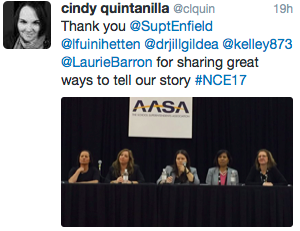 At #NCE17 this week, I was able to attend a session Improving Leadership Performance – 5 Tips to Maximize Your Leaders’ Potential faciliated by Mark Reardon, a former administrator and Lead Education Consultant for Quantum Learning.
At #NCE17 this week, I was able to attend a session Improving Leadership Performance – 5 Tips to Maximize Your Leaders’ Potential faciliated by Mark Reardon, a former administrator and Lead Education Consultant for Quantum Learning.
Mark spent time through the session helping us understand a formula for efficacy which includes consistency, confidence, competence, and effort. As leaders, we have the greatest impact on our supervisees’ competence. We hire individuals with the knowledge, dispositions, and skills which best meet our organization’s culture. We provide professional learning opportunities. We engage in conversations about our practice. Most importantly, we provide feedback. There is much research about feedback being “timely, specific, and actionable.” But, Mark shared a specific tool to help us as leaders give meaningful feedback to our colleagues.
My biggest takeaway from the session was the ACT framework for feedback. When providing feedback, Mark encouraged us to identify the action, include the characteristics, and highlight our target (or goal).
For example…
Action – I noticed you… or You___…
Characteristics – You displayed empathy when… or You thought carefully when…
Target – This helps us further our goal of… or This will help us to …
So, for example, let’s say a principal evaluates a teacher. In the post-conference evaluation form, the principal articulated clear commendations and recommendations based on the narrative of the observation.
As a leader, I could provide specific feedback along the lines of …
“John, I noticed on your evaluation of Ms. Smith, you provided clear recommendations for improving student engagement. You thought critically about her instructional practice and personal philosphy and made targeted recommendations which she can use to grow professionally. Improving instruction and student engagement helps us meet our goal of increasing student achievement.” Imagine the power this has over “Good job on that evaluation!”
What other strategies do you have for providing specific feedback in order to improve competence of our leaders?

